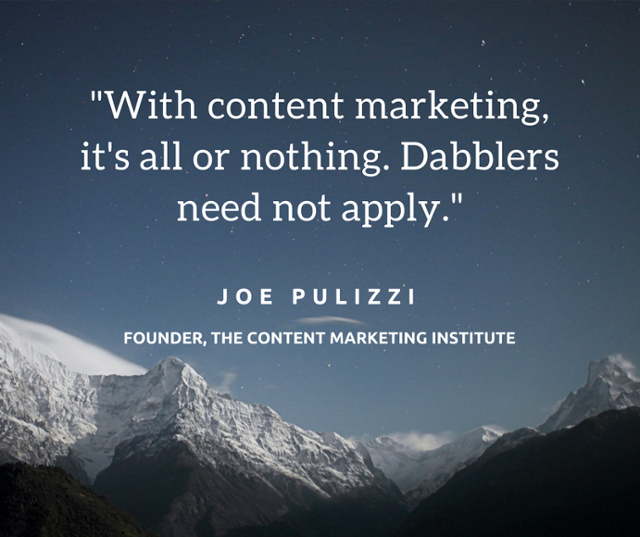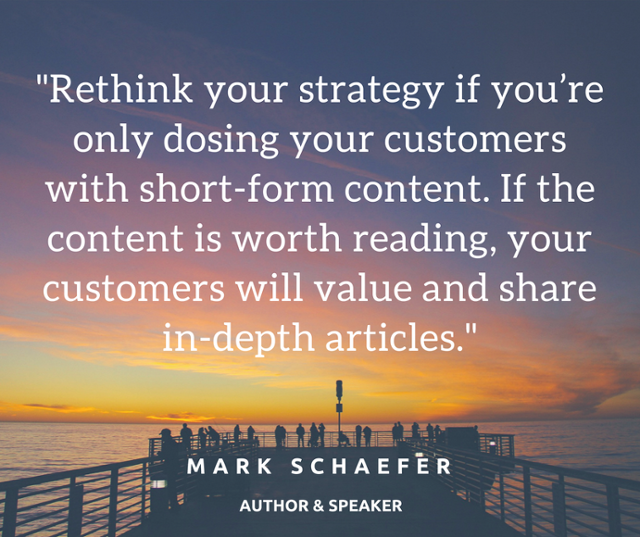At 6:25 a.m. on March 17, 2014, a magnitude 4.7 earthquake shook the greater Los Angeles area. A mere three minutes later, the Los Angeles Times became the first publication to break the story. How did they do it so quickly? Instead of waiting on a human being to research and report, the newspaper used a content robot that sourced information from the U.S. Geological Survey and compiled a simple article in seconds.
A few days later, one of my friends read about the Los Angeles Times news-writing algorithm and asked if I was scared this sort of artificial intelligence would make my job obsolete. And I laughed off the question. Psh. Robots.
But I’d be lying if I said a tiny part of me wasn’t a wee bit nervous.
Innovation can be scary. And naysayers have been prophesying the end of content writing for nearly a decade. But content creators are nothing if not resilient. We know how to pivot, reinvent and champion our cause. And so far we’ve been successful in this endeavor—88 percent of B2B marketers used content marketing in 2016, according to Content Marketing Institute.
But what does the future hold for what is, in my humble opinion, one of the greatest things that’s ever happened to marketing? Hold onto your hat, my friend. The winds of change are upon us.
1. Interactive Content Will Become Brands’ Hot New Must-Have
This is by no means a recent development, but it is becoming more popular as attention spans shrink and demand for immediate value grows. Quizzes, polls, surveys, calculators and guided self-assessments are visually stimulating and prompt readers to engage almost instantly. According to HubSpot’s The State of Inbound 2016, 42 percent of inbound marketers said creating interactive content is a top marketing priority in 2017.
What this means for you: Traditional blogging, eBooks and whitepapers are still important, but to outpace your competition you’ll need to add visually appealing interactive content to your resource arsenal.
2. Rise of “Fake News” Will Make Content Consumers More Cautious
Throughout 2016, the internet was rife with stories journalist Stephen Armstrong calls “the mix of outright lie, partisan opinion and conspiracy theory.” This fake news smeared presidential candidates, swayed public opinion and even prompted a North Carolina man to fire an assault rifle inside a Washington, D.C., pizza restaurant.
In recent weeks, social media outlets have taken measures to curb the spread of fake news and many content consumers have started doing their own fact-checking. We predict this trend will continue, with people becoming less likely to believe everything they read and more likely to avoid outlets that spread falsities.
What this means for you: Be ethical. Publish only well-researched content rooted in fact and never assume your prospects won’t do their homework.
3. Quality Over Quantity Will Reign Supreme
Since Google’s first Panda algorithm update in 2011, great content marketers have been pushing for quality content over quantity. In other words, there is no point in publishing several blog posts per week if they’re not earning traffic. Publishing frequency is just one of many factors that affect a site’s SEO ranking. And we’re going to see this idea evolve.
Instead of regurgitating the same “how-to’s” and top 10 lists as their competitors, the most successful brands will be those that put extra time and effort into their content. Expect to see more investigative journalism style long-form articles and provocative thought pieces produced by brands.
What this means for you: Work with writers trained in journalism who know how to chase a good story, conduct interviews and find a new and exciting angle.
4. Content Dabblers Will Waste a Lot of Money
In the December 2016 issue of the Content Marketing Institute’s print magazine Chief Content Officer, founder Joe Pulizzi warns that dabbling in content—that is, not fully committing to content marketing—is a waste of time. “With content marketing, it’s all or nothing.” Pulizzi says. “Dabblers need not apply.”
Brands that create content without a sound strategy and objective aren’t just going to waste their time, though. They’re also going to waste a lot of money and push good marketing employees out the door.
What this means for you: If your organization doesn’t have a full-fledged editorial calendar, well-planned content strategy tied to company objectives and a reliable method of measuring success, you have two choices: 1) Start doing all of the above (we can help!) or 2) Quit trying and miss out on significant lead generating potential.
5. Content Writers Will Need to Pivot (Again)
Ah, content writers. This career path sure is a rollercoaster. Many started this journey being forced to stuff their copy with keywords to the point of incoherent drivel, then pivoted to become researchers extraordinaire once Google put the kibosh on keyword stuffing and brands (finally) started demanding higher quality material. Now they’re chugging along creating blog posts that are both fun to write and interesting to read.
Time for another shake-up.
As mentioned above, content will morph into different forms over the next few years, and writers will need to acquire new skills to meet the demand. The ability to write short-but-gripping copy for interactive pieces and thoroughly investigated long-form articles that expose and uncover valuable and new information will become critical to their future.
What this means for you: Never (ever, ever) settle for mediocre writing. If you want to stand out from the noise, the copy you publish should be intriguing, enticing and just as well-written as the articles in your favorite magazine. Select content creators carefully and remember: When it comes to content writing, you get what you pay for.
6. Demand Generation Strategy Will Continue Growing in Complexity
In the marketing world, one of the only constants is change. Marketers know they have to continually be learning and evolving their skill set—and that’s half the fun. But for a business trying to quickly fill its sales pipeline with quality leads, all this change can be frustrating. There are few aspects of marketing where this rings truer than in demand generation.
In the past, we’ve talked about content slump: when your space has become so inundated with content contributors, you’re having trouble rising above the noise. Creating brilliant content won’t do much good if no one’s seeing it. Demand generation helps overcome this challenge by attracting and leading prospects right to your content through a mix of owned, earned and paid efforts.
From internally created content to publicity and paid media, the recipe for success changes as often as distribution channels change their rules (which is a lot.) And this constant evolution is speeding up exponentially.
What this means for you: Trying to keep up with the intricate and dynamic world of demand generation often requires the effort of a full-time team of experts. If you don’t have the time or budget to hire a full team, outsourcing to an experienced agency can relieve you of the burden and help you achieve greater success.
7. The Most Engaging Content Will Be Extra-Long or Extra-Short
As we’ve touched on already, content is undergoing a metamorphosis in which the uber short, concise and punchy copy (think billboard style) and lengthy, in-depth, long-form storytelling will become the two most engaging formats.
We’ll see shorter-style copy in places like interactive content and mobile applications—especially as the Internet of Things continues to grow. Long-form content will continue to be offered as eBooks and whitepapers, but we’ll also see ungated long-form editorial-style content edging in on blogs and in specialized publications.
“Rethink your strategy if you’re only dosing your customers with short-form content,” says content thought leader Mark Schaefer. “If the content is worth reading, your customers will value and share in-depth articles.”
What this means for you: It’s time to vary your content length, but only when it makes sense. In other words, don’t create a long-form article for the sake of long-form, but because the information you have to share can’t be summed up in short form.
Moving Forward
Content marketing isn’t dying. In fact, it’s arguably more alive and more important than ever. But the evolution is inevitable and complacency is the kiss of death to your content marketing strategy.
Keep the above seven predictions of the future of content marketing in mind as you plan the next few quarters and welcome change. But remember: While innovative marketing automation can (and should) edge in on some content marketing duties, a robot will never be able to enrapture an audience like a good (human) content creator.
Read more:


